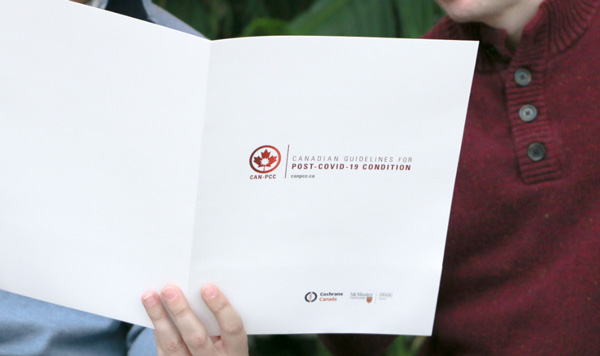Challenges and lessons learned from disseminating Canada’s long COVID guidelines
Introduction
The aftermath of the COVID-19 pandemic has led to unexpected public health challenges, especially in how evidence-based health recommendations are communicated. Our team experienced this firsthand while developing Canada’s guidelines for long COVID – a debilitating condition affecting millions in the country. The release of these guidelines, coupled with the increasing use of digital media, the spread of misinformation and the persistence of patient advocates, has resulted in an interesting case study of health communication.
Canada’s first guidelines for Post COVID-19 Condition (also known as long COVID)
The Canadian Guidelines for Post COVID-19 Condition (CAN-PCC) was a project led by Cochrane Canada and the McMaster GRADE Centres from February 2023 to March 2025 and funded by the Public Health Agency of Canada. Over 150 researchers, health professionals and patients from Canada’s provinces and territories and internationally, collaborated to develop, share and evaluate 112 evidence-based recommendations on long COVID. The recommendations cover six areas of long COVID management, including prevention, testing and diagnosis, clinical interventions, neurological and psychiatric topics, paediatrics and health systems.
Communication challenges despite rigorous guideline development methods
The guidelines followed an internationally endorsed standard for creating clinical practice guidelines called GRADE. The development methods involved over ten patients in the development process, sought monthly feedback from thousands of individuals and organisational representatives on draft recommendations and included a first-of-its-kind equity oversight committee.
Alongside the development of the recommendations was the effort to share guidelines in English and French to health professionals, patients and policymakers in Canada. For the knowledge translation (KT) aspect, the CAN-PCC project recruited a large committee of experts who followed a framework based on CIHR’s KT planning guideline and the Knowledge-to-Action cycle. Overall, the CAN-PCC team created 112 plain language recommendations, 81 online resource sheets (including language translations), interactive infographics for patients, 17 webinars (including 10 accredited webinars for health professionals), an evidence-based medicine training program and an information kit for policymakers. Furthermore, the project attempted to engage over 200 organisations at the federal, provincial and regional levels in Canada, building relationships and tailoring communications to promote the recommendations. A newsletter subscriber base of over 2,100+ individuals was built and CAN-PCC received recognition in the press (CBC, Toronto Star and Hamilton Spectator).

Despite our rigorous methods and inclusive process, online social media conversations and responses to public comment surveys contained mixed feedback. Patients echoed that their symptoms were continuously dismissed by health professionals, despite the release of recommendations. Parents were concerned about the psychologisation of long COVID in children while other participants loudly expressed concerns on social media about the recommendation’s language, the composition of the CAN-PCC guideline teams and short timelines for feedback on draft recommendations. Most importantly, patients shared their dissatisfaction with conditional recommendations for exercise-based and mental health interventions.
An example: communicating contentious recommendations that are conditional with very low certainty of evidence
Although project timelines could not be altered, our team prioritised addressing our audience’s concerns. For example, we attempted to communicate the concepts of certainty of evidence and conditional recommendations and what this means for health care decision-making in a way that enhances trust in our project. Three memorable knowledge mobilisation (KM) strategies that were used to address this challenge included:
- Creation of video explainers: Health care professionals, research staff and graphic designers collaborated to create short videos from the perspective of a doctor to explain what long COVID is and what low certainty of the evidence means. These videos were shared through YouTube, newsletters and Cochrane Canada’s social media channels. This helped to communicate the real impact of the condition, humanise the project and explain scientific GRADE concepts in a relevant format to the online community.
- Plain language recommendations: Initially, we promoted the standard language recommendations through social media and our newsletters. However, after online feedback describing that the recommendation language was difficult to understand, we consequentially began to promote the plain language versions in our newsletters and online announcements. These easy-to-understand formats are written at a health literacy level of Grade 8, reviewed by medical and citizen editors and refined with grammatical tools such as the Hemmingway Editor.
- Webinars: In live webinars, our guideline team members explained important guideline methods before presenting the recommendations. This included descriptions about what strong and conditional recommendations mean to policymakers, health professionals, patients and the public. This provided a helpful primer for those who are unfamiliar with GRADE methods.
Key lessons to consider for communicating guidelines
- Anticipate responses to controversial topics and be adaptable with communication strategies: Although we had an extensively planned KM strategy incorporating co-design, unexpected feedback from patients about recommendations for exercise-based interventions and from the online community meant we had to tailor communication about the project in real time. Thus, it is important to listen to your target audience, monitor the online responses of patient advocates and critics and be prepared to respond to repeated concerns in a timely and respectful way.
- Build considerable time to communicate, disseminate and implement guidelines: Co-designing products and resources in English and French and developing strategies to address unexpected communication challenges took significant time. For example, video creation can involve days to weeks of drafting, filming, branding and editing. Co-designed resources required meaningful involvement and dialogue from interest-holders. Identifying and digitally building relationships with health organisations requires consistent efforts via email and online calls. Thus, future guideline projects should consider these potential challenges when planning to disseminate large-scale trustworthy and clear guidelines.
References
Public Health Agency of Canada. COVID-19 longer-term symptoms among Canadian adults [Internet]. 2023 [cited 2025 Sep 29]. Available from: https://health-infobase.canada.ca/covid-19/post-covid-condition/
Canadian Guidelines for Post-COVID-19 Condition (CAN-PCC) [Internet]. [cited 2025 Sep 29]. Available from: https://canpcc.ca/
CAN-PCC Recommendations Map [Internet]. [cited 2025 Sep 29]. Available from: https://can-pcc.recmap.org/recommendations
GRADE [Internet]. [cited 2025 Sep 29]. Available from: https://book.gradepro.org/
Government of Canada, Canadian Institute of Health Research. Guide to Knowledge Translation Planning at CIHR: Integrated and End-of-Grant Approaches - CIHR [Internet]. 2012 [cited 2025 Sep 29]. Available from: https://cihr-irsc.gc.ca/e/45321.html
Graham ID, Logan J, Harrison MB, Straus SE, Tetroe J, Caswell W, et al. Lost in knowledge translation: time for a map? J Contin Educ Health Prof. 2006;26(1):13–24.
Plain Language Recommendations - CAN-PCC Recommendations Map [Internet]. [cited 2025 Sep 29]. Available from: https://can-pcc.recmap.org/plrs?searchMode=plr
Resources - Canadian Guidelines for Post-COVID-19 Condition (CAN-PCC) [Internet]. [cited 2025 Sep 29]. Available from: https://canpcc.ca/resources/#tab-content-ov
ARCHE. Arche Infographics. [cited 2025 Sep 29]. Alberta Research Centre for Health Evidence - CAN-PCC Infographics. Available from: https://www.archeinfographics.com
Past Events - Canadian Guidelines for Post-COVID-19 Condition (CAN-PCC). Available from: https://canpcc.ca/events/
EBM Connect Canada – Canadian Collaboration For Immigrant and Refugee Health [Internet]. [cited 2025 Sep 29]. Available from: https://ccirhken.ca/ebm-connect-canada/
Brown D. McMaster University researchers create guidelines to help COVID-19 longhaulers. CBC News [Internet]. 2025 Mar 28 [cited 2025 Sep 29]; Available from: https://www.cbc.ca/news/canada/hamilton/hamilton-mcmaster-university-post-covid-19-guidelines-1.7494976
Jiang, K. Long COVID: What we know and how to tell if you have it. Toronto Star. [Internet]. 2025 Aug 16 [cited 2025 Sep 29]. Available from: https://www.thestar.com/news/canada/do-you-have-long-covid-heres-how-to-tell-and-what-we-know-about-the/article_c32b9f1f-e7f8-4609-9715-d30712bd11e2.html
Frketich J. Guide to navigating long COVID created by Hamilton-led team. The Hamilton Spectator [Internet]. 2025 Aug 14 [cited 2025 Sep 29]; Available from: https://www.thespec.com/news/hamilton-region/guide-to-navigating-long-covid-created-by-hamilton-led-team/article_1cf5b324-df65-5627-aa52-5ba14e9c7a24.html
What is Post COVID Condition? [Internet]. 2025 [cited 2025 Sep 29]. Available from: https://www.youtube.com/watch?v=ghU6jUmxh4M
What do we do with very low certainty of evidence? [Internet]. [cited 2025 Sep 29]. Available from: https://www.youtube.com/shorts/ZYHc6eNkqI0
To link to this article - DOI: https://doi.org/10.70253/JXWR1141
Links to additional resources
Canadian Guidelines for Post COVID-19 Condition: canpcc.ca
Disclaimer
The authors received financial support from a Public Health Agency of Canada grant to create the Canadian Guidelines for Post COVID-19 Condition.
The views expressed in this World EBHC Day Blog, as well as any errors or omissions, are the sole responsibility of the author and do not represent the views of the World EBHC Day Steering Committee, Official Partners or Sponsors; nor does it imply endorsement by the aforementioned parties.
